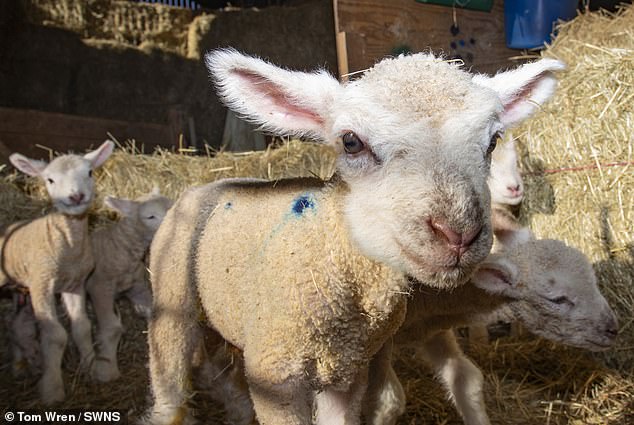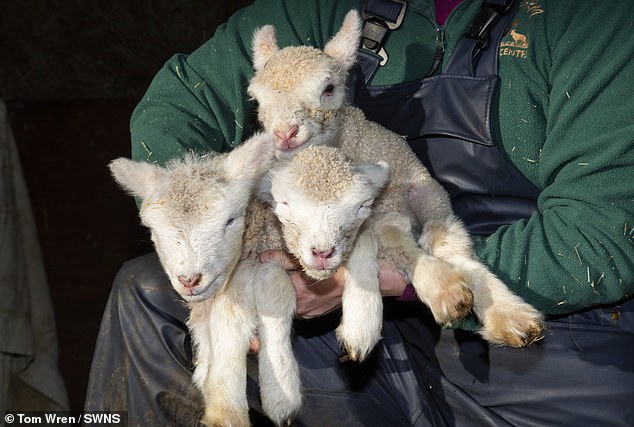Ewe’ve got to be kidding! Farmer’s delight after her flock gives birth to four sets of triplet lambs within days of each other
- Roves Farm, near Swindon, delivered 70 lambs in one month
- Poll Dorsets are the only native sheep that can breed all year round
A farmer was stunned when her flock gave birth to four sets of triplet lambs within days of each other.
Roves Farm, near Swindon, normally welcomes one or two pairs of triplets from its flock of ewes, but is celebrating four births in a week, a feat that is almost unheard of.
Shepherdess Pippa Bolter, who manages the Poll Dorset flock at the working farm and visitor centre, said the record number of arrivals earlier this month was ‘fantastic’.
Although the birth of lambs is often associated with spring, Poll Dorsets are the only native sheep that can reproduce all year round.
The latest births have made the Wiltshire farm’s lamb shed extra busy, with more than 70 newborns due to be born within a month and the last few expected next week.
Pippa Bolter, who manages the Poll Dorset herd at Roves Farm near Swindon, said the record number of arrivals earlier this month was ‘fantastic’.

The latest births have made the Wiltshire farm’s lamb shed extra busy, with more than 70 lambs delivered in one month and the last few expected next week.

The first trio of lambs were all girls and the second set included two girls and a boy
Pippa said: ‘Triplets are not uncommon, but we normally have one or two. This year we’ve had four in the past few days. This breed is very relaxed and friendly and their niche is that they lamb earlier than other breeds.’
Roves Farm has two breeds on site: the Poll Dorsets, which are lambed in January and the Continentals, which are laminated in April.
There are currently 50 ewes in the lambing shed, some with singleton births, some with twins and now four with triplets.
The first trio consisted of all girls and the second set consisted of two girls and a boy. The gender of the other two triples has not been confirmed.
Pippa added: “We will be delivering lambs from our Continental ewes in April. Last year we had two sets of quintuplets, which was really rare.’
The center scans expectant mothers after 90 days to ensure they are feeding the correct amount, because ‘a ewe feeding one lamb does not need as much as a ewe with three lambs’.
If a ewe has more than two lambs, Pippa and her team will adopt the extra lambs from a ewe that only has one, to ensure all the young are properly fed.
Pippa added: ‘If a ewe has more than two lambs, we will adopt extra lambs from a ewe that only has one lamb, as ewes only have two teats so can only feed two lambs at a time.
“The only way she’ll accept the lamb is if we give her a bath in her lamb so it smells like her. It’s not perfect, but it usually works.
‘Then we put her real lamb next to her and she usually doesn’t notice that she hasn’t given birth a second time.
“After drinking her milk for a few days, it will smell like her.”
